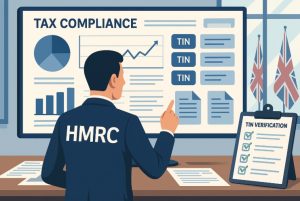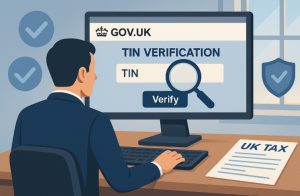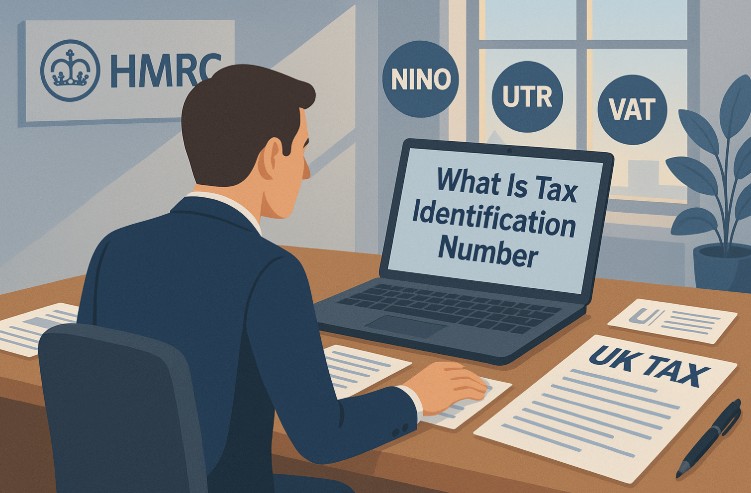Last Updated on: 25th July 2025, 09:50 am
Have you ever filled out a tax form or registered a business and been asked for a Tax Identification Number? If you’re unsure what that means or why it’s needed, you’re not alone.
In the UK, various identifiers, such as your National Insurance Number, Unique Taxpayer Reference, and Company Registration Number, function as Tax Identification Numbers depending on your situation.
These references are essential for staying compliant with HMRC, managing your tax records, and avoiding penalties.
Whether you’re employed, self-employed, running a limited company, or trading internationally, knowing how TINs work can help you meet your legal obligations and operate with confidence.
In this article, you’ll learn what a Tax Identification Number is, the types issued in the UK, how to apply for one, and how they’re used for domestic and international tax compliance. Let’s break it down simply and clearly.
What Is A TIN Number?

A Tax Identification Number (TIN) is a unique reference assigned to you or your business to track your tax-related activities. It is used by HM Revenue and Customs (HMRC) to identify taxpayers, verify submitted information, and ensure compliance with UK tax laws.
You need a TIN if you are responsible for reporting income, filing tax returns, or managing VAT. Without a TIN, your ability to operate legally or access government tax services may be limited.
TINs are essential for:
- Accurately linking individuals and businesses with HMRC records
- Ensuring correct filing of self-assessment and corporation tax
- Complying with national and international tax regulations
- Verifying your tax status during audits or cross-border transactions
Whether you’re employed, self-employed, or managing a company, you’ll interact with at least one form of TIN.
What Are The Main Types Of TIN Numbers In The UK?
There isn’t a single universal TIN in the UK. Instead, multiple identifiers serve as tax numbers depending on your circumstances.
These identifiers include the Unique Taxpayer Reference (UTR), National Insurance Number (NINO), Company Registration Number (CRN), and VAT Registration Number.
What Is A UTR And When Is It Used?
A Unique Taxpayer Reference (UTR) is a 10-digit number issued by HMRC.
It’s mainly used for:
- Self-assessment tax returns
- Corporation tax
- Partnership or trust tax obligations
You receive a UTR when you register for self-assessment or incorporate a company.
How Is A VAT Registration Number Related To TINs?
If your business is VAT-registered, HMRC assigns you a VAT Registration Number.
This number is used to:
- File VAT returns
- Charge and reclaim VAT
- Identify your business in the EU and UK trade
The VAT number typically begins with “GB” followed by nine digits.
What Is The Difference Between A NINO And A TIN?
Your National Insurance Number (NINO) functions as a TIN for most individual taxpayers.
It’s issued by the Department for Work and Pensions (DWP) and used to track:
- National Insurance contributions
- PAYE (Pay As You Earn) tax
- State pension eligibility
Each identifier has a defined purpose, and you may have more than one depending on your tax responsibilities.
What Is The Format And Structure Of UK TIN Numbers?

Each type of TIN in the UK follows a specific format. Knowing how these identifiers are structured helps you verify your details and ensure accuracy in official documents.
Here is a comparison of the most common TIN types used in the UK:
| TIN Type | Format Example | Applicable To | Issued By |
| UTR | 1234567890 | Self-employed, companies | HMRC |
| NINO | QQ123456C | Individuals | HMRC / DWP |
| CRN | 12345678 or SC123456 | Limited companies | Companies House |
| VAT Number | GB123456789 | VAT-registered businesses | HMRC |
| UTR (Trusts/Partnerships) | 1234567890 | Trusts, general partnerships | HMRC |
These identifiers must be used consistently in your tax filings and correspondence with HMRC. Incorrect or missing numbers may delay tax processing or lead to compliance checks.
How Can You Apply For A Tax Identification Number?
If you are starting a business, becoming self-employed, registering for VAT, or starting a new job in the UK, you will need to obtain a Tax Identification Number (TIN) relevant to your circumstances.
The application process varies depending on the type of TIN you require, such as a UTR for self-assessment, a NINO for employment, a CRN for company registration, or a VAT number for trading.
It is essential that you register with the correct authority and provide accurate details to avoid delays or rejections.
What Is The Process For Obtaining A TIN In The UK?
The process of obtaining a TIN depends on your taxpayer status. Here’s how it generally works:
- Self-employed individuals: Register for self-assessment on HMRC’s website. A UTR will be sent by post.
- Employees and residents: You’re automatically issued a NINO around the age of 16 or when you apply to work in the UK.
- Companies: A CRN is provided upon incorporation via Companies House. HMRC will later issue the company’s UTR.
What Documents Do You Need To Apply For A TIN?
To complete the registration, you’ll be asked to provide:
- Proof of identity (passport or driving licence)
- Proof of address (utility bill or bank statement)
- Business details (name, structure, industry)
- National Insurance number (if applying for a UTR as an individual)
These documents help HMRC verify your identity and eligibility for the relevant TIN.
Where Should You Register For A TIN With HMRC?
You can register through the following channels:
- Self-assessment and UTR: Visit HMRC’s online self-assessment portal
- NINO: Apply through gov.uk
- Company tax: Automatically initiated when registering a company with Companies House
After submission, HMRC typically sends your UTR by post within 10 working days.
How Does A TIN Ensure Compliance With UK Tax Laws?

TINs are vital for enforcing tax laws. They act as official identifiers in HMRC’s databases, linking you or your business to tax filings, payments, and audits.
Why Is TIN Important For HMRC Compliance?
TINs allow HMRC to:
- Monitor tax returns and payments
- Verify identities and prevent fraud
- Track business activity across platforms
- Ensure accurate VAT and PAYE records
When HMRC investigates discrepancies or queries a tax return, your TIN ensures they can quickly retrieve the correct account.
What Happens If You Don’t Have A Valid TIN?
If you do not have the appropriate TIN:
- Your tax submissions may be rejected
- Refunds could be delayed
- You may be issued penalties for non-compliance
- You could be barred from accessing certain HMRC services
It’s your responsibility to ensure the TIN is correct and up to date.
How Can You Update Your TIN Records?
You can update your tax information through:
- Your HMRC online account
- Written correspondence with HMRC
- Speaking with an authorised agent or accountant
Always keep HMRC informed of changes to your name, address, or business activities to avoid miscommunication or missed deadlines.
Why Are TIN Numbers Important For International Transactions?

TINs play a significant role in cross-border tax compliance. Under global tax agreements like the Common Reporting Standard (CRS), UK financial institutions must share information about taxpayers with HMRC, who may then share it with other countries.
Do You Need A TIN For Cross-Border Business?
If you’re conducting international business, your TIN is required for:
- Verifying identity when opening foreign bank accounts
- Facilitating cross-border payments
- Completing declarations under the CRS
TINs are commonly required by online platforms, banks, and tax authorities to ensure full transparency and regulatory compliance.
How Does A TIN Help In International Tax Compliance?
Your TIN supports:
- The prevention of tax evasion
- Reporting foreign income to HMRC
- Mutual exchange of information between jurisdictions
- Accurate withholding tax processing
TINs ensure that your financial activity abroad is properly reported and taxed according to domestic and international law.
What If You’re Dealing With Sellers In Other Jurisdictions?
If you operate a digital platform or payment gateway, you’re responsible for collecting the seller’s TIN from their country of residence.
This is especially important if:
- The seller is not a UK resident
- The country does not require TINs or only provides functional equivalents
- You’re reporting income to HMRC or a foreign tax authority
If a seller cannot provide a TIN, you must document the reason and, where applicable, use reporting codes such as “NOTIN” as per HMRC’s guidance.
How Can You Verify And Validate A TIN Number?

Validation helps ensure that the TIN you’ve received is correct and matches the individual or business it’s assigned to.
How Do HMRC And Businesses Verify A TIN?
HMRC verifies TINs internally against their records. As a business or agent, you can validate TINs using official tools.
Useful verification resources include:
- HMRC’s agent portal for checking UTRs
- Employers’ access to validate NINOs through payroll systems
- The Companies House register for CRNs
- The VIES system for checking EU VAT numbers
Are There Tools To Check TIN Validity Online?
Yes. Below are reliable resources you can use:
| Identifier | Verification Source |
| UTR | HMRC online account |
| NINO | Employer records, HMRC letters |
| CRN | Companies House company search |
| VAT Number | EU VIES (for EU checks), HMRC VAT checker |
Incorrect TINs could delay reporting and may result in additional compliance checks. Always verify the structure and issue authority before submission.
What Happens If A TIN Is Not Recognised Or Is Missing?
In cases where a TIN cannot be provided:
- HMRC may allow temporary registration but require follow-up
- Businesses may need to use placeholder codes such as “NOTIN”
- Proof of attempts to collect the TIN should be retained
You should also confirm whether the seller’s country issues TINs or accepts alternatives such as a social security or registration number.
Conclusion
Understanding your Tax Identification Number is vital for fulfilling your tax obligations and keeping your financial records in good standing. Whether it’s a UTR, NINO, CRN, or VAT number, each plays a specific role in how HMRC identifies and manages taxpayers in the UK.
These identifiers ensure accurate reporting, reduce the risk of errors, and support compliance with both national and international tax rules. If you’re self-employed, running a company, or involved in cross-border trade, having the correct TIN is not just a requirement, it’s a critical part of managing your responsibilities as a taxpayer.
By knowing how to apply for, verify, and use the correct TIN, you can avoid penalties, streamline your filings, and ensure your business or personal tax affairs remain fully compliant. Always keep your tax reference details up to date and accessible to stay ahead of your obligations.
FAQs
Is my National Insurance Number the same as a TIN?
Yes, for most individuals in the UK, your National Insurance Number acts as your TIN.
Can I have more than one TIN if I live in multiple countries?
Yes. If you’re tax resident in more than one country, each may issue you a TIN.
How long does it take to get a TIN from HMRC?
It can take a few weeks, depending on the type of TIN. UTRs and NINOs typically take 2–4 weeks after registration.
What’s the difference between UTR and TIN in the UK?
A UTR is a specific type of TIN used for self-assessment and business taxes.
Do freelancers and contractors need a TIN?
Yes. If you’re self-employed, you’ll need a UTR from HMRC for tax filings.
Can a business operate without a TIN in the UK?
Temporarily, yes. However, a valid TIN must be obtained to remain compliant.
What should I do if I’ve lost my TIN or UTR number?
You can recover it through your HMRC online account or by contacting HMRC directly.
Recent Posts




















No Comments
Leave a comment Cancel